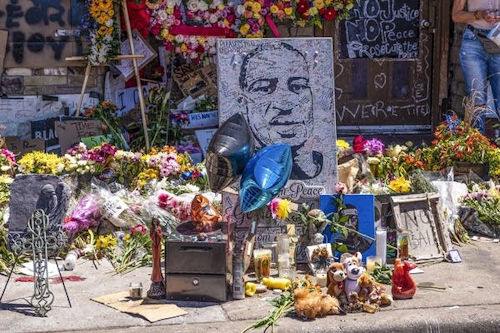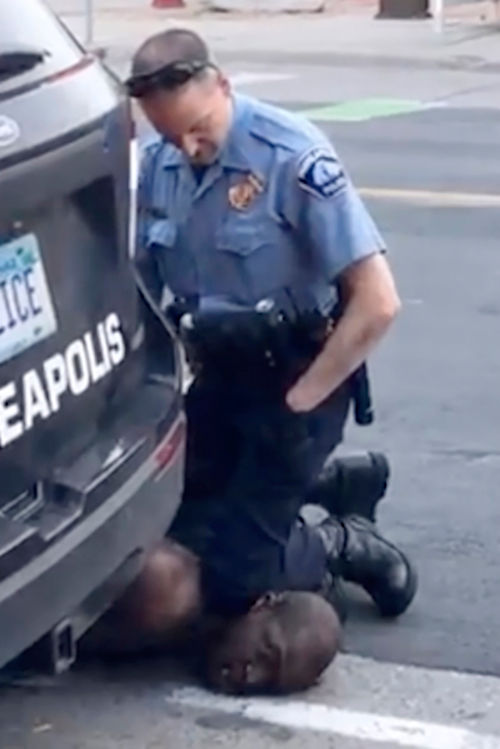George Floyd Murder (Chauvin) Trial (2021)
Derek Chauvin (George Floyd Murder) Trial
by Douglas O. Linder (2023)

The shocking death of George Floyd on May 20, 2020 following a neck restraint applied by Minneapolis police officer Derek Chauvin in the presence of three other officers--a scene captured on video and viewed by hundreds of millions of people--set off a wave of violent protests in Minneapolis and around the world. Commentators and the majority of the public saw the excessive use of force by a white officer against a black man as an example of entrenched police racism and the lack of equal justice under the law. While no one should doubt that racism remains a problem in the United States, there was very little evidence in the case to suggest that Chauvin's actions were racially motivated. Also, it is worth noting, none of the three other officers charged in the case, including an African-American, an Asian-American, and a Caucasian, had a history of racial animus. Race and racism hardly warranted a mention in the trial that followed. Defendant Derek Chauvin, at his worst, was an "equal-opportunity" bad cop with a record of using excessive force against both black and white suspects. But facts often matter little in the court of public opinion, where first-take narratives tend to take on a life of their own. Given the public protests and general outcry, the pressure on prosecutors, jurors, and judges to come down heavily on Chauvin was immense, and his resulting stiff sentence (and even his near-murder three years later in a federal prison) should have come as no surprise to close observers of the trial that came to symbolize so much more than it was actually about.
The Death of George Floyd
About 8:00 on the evening of May 25, 2020, Darnella Frazier’s 9-year-old cousin asked her if she would take her to a Cup Foods store near their south Minneapolis apartment. Darella, 17, and her young cousin were a few storefronts down from the grocery store when she saw four officers pull a black motorist roughly from his vehicle. Darnella pulled out her iPhone and began recording. Portions of Darnella's video would be replayed tens of thousands of times and spark a movement across America that will forever change race relations in this county.

The video was shocking. It showed Minneapolis police officer Derek Chauvin using his knee to pin a handcuffed 46-year-old African American, George Floyd, to the pavement--for seven minutes and forty-six seconds. When Chauvin began applying knee pressure to Floyd’s neck, officer Thomas Lane put pressure on his legs. Officer Thao stood nearby, in an apparent effort to separate bystanders from the unfolding scene. In the video, Floyd said “I can’t breathe”—sixteen times. He said, “My stomach hurts, my neck hurts, everything hurts.” He called out “Please” and “Mama.” Floyd at one point said, “I’m about to die.” Chauvin told him to “relax.” Concerned witnesses begged Chauvin to take his knee off of Floyd’s neck. Chauvin was unmoved. Thao was also unmoved, telling observers Floyd was “talking” and “he’s fine” and—seizing the moment for a public service announcement—“This is why you don’t do drugs.”
About five minutes into the video, Floyd appeared to be unconscious. Chauvin pulled out mace to keep worried bystanders from intervening. Thao moved directly between the bystanders and Chauvin. One observer demanded that officers check Floyd’s pulse. Officer Lane was concerned enough to twice ask Chauvin whether they should move Floyd to his side. Chauvin said no.
At 8:27 pm, with Chauvin’s knee still on Floyd’s neck, a Hennepin County ambulance, called to the scene by officers, arrived. Finally, after nearly nine minutes of applying pressure, Chauvin released his knee. Paramedics loaded the silent and unconscious Floyd onto a stretcher, carried him to an ambulance, and raced off for the Hennepin County Medical Center. Darella Frazier’s video ends at this point. It is, arguably, the most consequential spontaneous video recording in history.
Aboard the ambulance, Floyd went into cardiac arrest. Paramedics requested that firefighters meet the ambulance at the corner of 36th Street and Park Avenue. Fire department medics found Floyd unresponsive and without a pulse. At 9:25 pm, Floyd was pronounced dead at the Hennepin Medical Center emergency room.
All over Twenty Dollars
The Minneapolis tragedy depicted in the video had begun when a Cup Foods employee called 911 to report that Floyd had purchased a pack of cigarettes with a counterfeit $20 bill. . . .Continued
